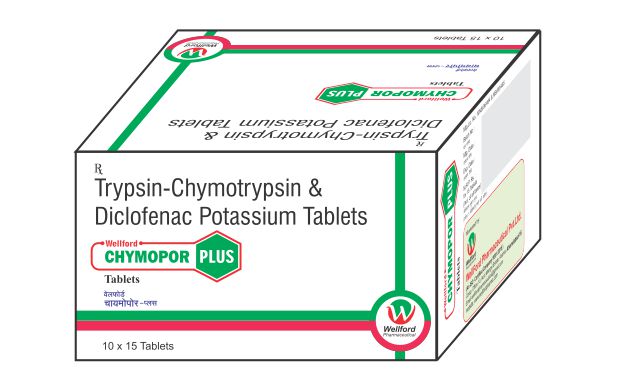Diclofenac is a non-steroidal anti-inflammatory drug (NSAID) which works by blocking the release of certain chemical messengers in the brain that are responsible for pain, fever and inflammation (redness and swelling). Trypsin Chymotrypsin is a combination of enzymes which break down proteins into smaller fragments, thereby making them available for absorption into the blood. Once absorbed, they increase blood supply in the affected area and reduce swelling.
Indications
This medicine helps in decreasing pain and swelling. It lowers the levels of chemical substances in the body that cause pain and swelling.
Uses
● This drug is used to treat different types of muscle and joint injuries, accompanied by swelling.
● For the management of edema associated with dental procedures (e.g. swelling of the tooth or swelling of the gums) and inflammation.
● For reduction of edema associated with surgical wounds and sinusitis.
● Used to treat ulcerative colitis, hay fever, pulmonary edema and shortening of labor.
● Used to treat sciatica
● It can be taken after hysterectomy (uterus removal)
● Treatment of hematomas.
● After surgical trauma.
● Used to treat necrotic tissue
● It is used to treat pelvic inflammatory diseases
● It is also used to treat chronic respiratory diseases.
Mechanism of Action
This is a combination of two drugs: Diclofenac (Nonsteroidal anti-inflammatory drug) and Trypsin-Chymotrypsin (Enzymes). Diclofenac blocks the chemical messengers that cause pain and inflammation. Trypsin-Chymotrypsin enzymes work by reducing redness and swelling by breaking down proteins into smaller fragments at affected areas, thereby proteins absorb into blood and increase blood supply at the affected area.
Precaution
This tablet should be avoided in patients allergic to trypsin or chymotrypsin or other similar enzymes.
Side Effects
Nausea, vomiting, abdominal pain, bloating, blood in the urine and allergy. Symptoms of an allergy can include: ● Skin rash,
● Redness of the skin,
● Itching of the skin,
● Swelling of the throat, tongue and face,
● Trouble breathing.
Drug Interaction
● Alcohol
● Chloramphenicol
Storage
Store in a cool, dry & dark Place. Protected from the direct sunlight.
Disclaimer:The data uploaded is made from content already available on internet.The company holds no right of it and is not responsible for any wrong information.
